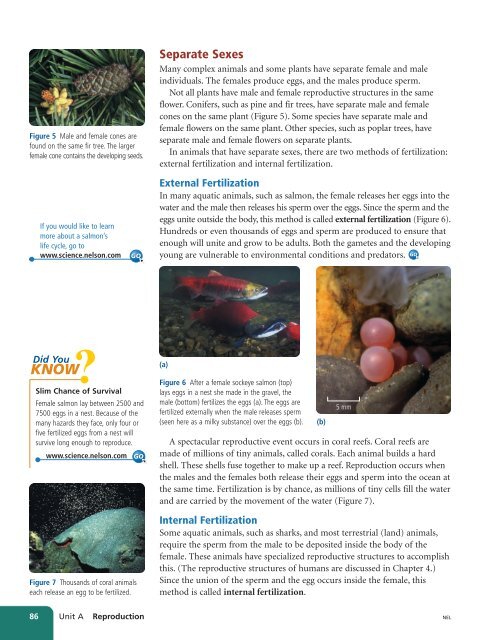Unit A Reproduction
Unit A Reproduction
Unit A Reproduction
You also want an ePaper? Increase the reach of your titles
YUMPU automatically turns print PDFs into web optimized ePapers that Google loves.
Figure 5 Male and female cones are<br />
found on the same fir tree. The larger<br />
female cone contains the developing seeds.<br />
Separate Sexes<br />
Many complex animals and some plants have separate female and male<br />
individuals. The females produce eggs, and the males produce sperm.<br />
Not all plants have male and female reproductive structures in the same<br />
flower. Conifers, such as pine and fir trees, have separate male and female<br />
cones on the same plant (Figure 5). Some species have separate male and<br />
female flowers on the same plant. Other species, such as poplar trees, have<br />
separate male and female flowers on separate plants.<br />
In animals that have separate sexes, there are two methods of fertilization:<br />
external fertilization and internal fertilization.<br />
If you would like to learn<br />
more about a salmon’s<br />
life cycle, go to<br />
www.science.nelson.com<br />
GO<br />
External Fertilization<br />
In many aquatic animals, such as salmon, the female releases her eggs into the<br />
water and the male then releases his sperm over the eggs. Since the sperm and the<br />
eggs unite outside the body, this method is called external fertilization (Figure 6).<br />
Hundreds or even thousands of eggs and sperm are produced to ensure that<br />
enough will unite and grow to be adults. Both the gametes and the developing<br />
young are vulnerable to environmental conditions and predators. GO<br />
Did You<br />
KNOW?<br />
Slim Chance of Survival<br />
Female salmon lay between 2500 and<br />
7500 eggs in a nest. Because of the<br />
many hazards they face, only four or<br />
five fertilized eggs from a nest will<br />
survive long enough to reproduce.<br />
www.science.nelson.com<br />
Figure 7 Thousands of coral animals<br />
each release an egg to be fertilized.<br />
GO<br />
(a)<br />
Figure 6 After a female sockeye salmon (top)<br />
lays eggs in a nest she made in the gravel, the<br />
male (bottom) fertilizes the eggs (a). The eggs are<br />
fertilized externally when the male releases sperm<br />
(seen here as a milky substance) over the eggs (b).<br />
5 mm<br />
A spectacular reproductive event occurs in coral reefs. Coral reefs are<br />
made of millions of tiny animals, called corals. Each animal builds a hard<br />
shell. These shells fuse together to make up a reef. <strong>Reproduction</strong> occurs when<br />
the males and the females both release their eggs and sperm into the ocean at<br />
the same time. Fertilization is by chance, as millions of tiny cells fill the water<br />
and are carried by the movement of the water (Figure 7).<br />
Internal Fertilization<br />
Some aquatic animals, such as sharks, and most terrestrial (land) animals,<br />
require the sperm from the male to be deposited inside the body of the<br />
female. These animals have specialized reproductive structures to accomplish<br />
this. (The reproductive structures of humans are discussed in Chapter 4.)<br />
Since the union of the sperm and the egg occurs inside the female, this<br />
method is called internal fertilization.<br />
(b)<br />
86 <strong>Unit</strong> A <strong>Reproduction</strong><br />
NEL

















